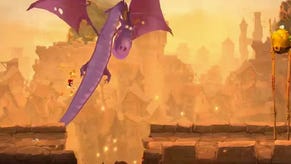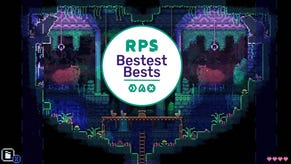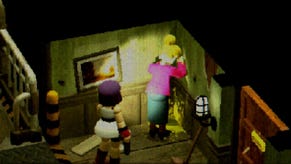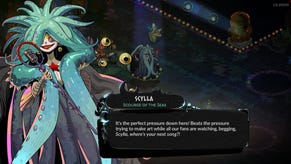Wot I Think: Rayman – Legumes
The French Perfection
Rayman: Legends Legumes is the sequel to the unexpectedly brilliant Rayman: Origins Oranges. The latter, starring a character that I had little interest in and whose style of running and jumping didn't seem particularly suited to the PC, was one of my favourite games of last year. With that in mind, I approached Legumes without any prejudice but instead with a deep-seated cynicism. I am nothing if not my doubts. But is this a rushed and inconsequential sequel or another platforming classic? Here's wot I think.
Rayman shows his disembodied hand early, but he doesn’t run out of tricks until Legends is complete. In the game’s first set of levels, each of which is locked inside a themed painting, one particular event involves a chase through a sandstorm. I’d been playing for around an hour when I first sprinted into the desert, wall-jumping frantically through the interior of buildings even as they collapsed into the Sarlaccian maw that yawned below.
Like many of Origins most memorable levels, it’s a moment that jettisons any notion of exploration, relying instead upon timing and spectacle. As a set piece, it’s a brief and exquisite side-scrolling recreation of the kind of situation Naughty Dog throw Nathan Drake into – a mad scramble, impossible for the hapless hero to survive without just the right dollop of dumb luck. Except there is no dumb luck here. Rayman is a more competent protagonist than Nathan Drake, and almost anyone else in game, as are all of the other unlockable characters, who range from reskinned returning allies to barbarian princesses.
There’s no room for mistakes, although that’s not to say that this new Rayman is an impenetrable challenge. Anyone who isn’t immediately turned off by the idea of jumping, running and collecting trinkets will effortlessly while away many hours in the game. The generosity of the unlocks provides fresh options and entertainment following almost every few minutes of play. Even a moderately successful attempt at a new level will usually provide access to at least one new area, including unique zones that change the rules of play in various ways.
There are also lucky scratch cards, earned between the silver and gold rating for each level, which provide random rewards, from a collection of pet creatures to returning levels from Origins. If the enormous amount of exquisitely designed, illustrated and soundtracked content weren’t enough, there are also daily and weekly challenges, with ever-changing takes on smaller arenas and parts of levels. These then provide access to online leaderboards that lead to further rewards.
It’s the kind of game I dreamed of owning as a child, when my parents could only afford to buy me one new cartridge or set of disks once every few months. A seemingly small package, with an apparently limited skill-set required, that unfolds into an enormous canvas. None of that would be relevant if the individual panels weren’t up to scratch but thankfully that’s not the case. This isn’t Cecilia Giménez’ Sistine Chapel restoration.
Incredibly, it’s a more attractive game than Origins, which was surely one of the most handsome games released last year. I was initially concerned that additional 3d modelling and animations would detract from the painted vision that made Rayman’s return so remarkable, but those elements are non-intrusive. It’s the detail in animations and backgrounds that give the world its life. Enemies rarely just stand, waiting. They’re torturing a Lum in some way, using it as a ping pong ball or a yoyo, and they transition beautifully between states, brandishing weapons, reacting to a punch, or taking a plunge and struggling for breath.
While powers do have to be unlocked again, meaning early levels are simpler and less challenging, the difficulty increases much faster than it did in Origins. From the first stage, a new mode of interaction is possible as Rayman’s guide Murfy now takes on an active role, hovering between points of interest and activated by the push of a button. His role varies, from activating levers and cutting ropes to change the layout of an area, to tickling, poking or slapping enemies to distract or displace them. In later levels, this adds an extra layer of complexity and with perfect timing, seconds can be shaved off the clock.
Murfy doesn’t appear in every level but there’s often something to mark an area out as unique, whether it’s a maze-like structure to navigate or the invasion of a SHMUP influence. There’s more choice from an early stage as well, with several plateaus of unlocks that gift levels from various worlds to the curious player. I tended to play in sequence, attempting to earn top marks before moving on in each instance, but there’s no obligation to do so. Fancy diving straight into the underwater world, which offers some of the game’s most striking and challenging levels? It’ll take less than a couple of hours to gain access. Only the final world - which isn’t really the final world at all - has a high threshold of entry. For the dedicated player, the other levels become farms to repeatedly visit in the hope of earning access to the endgame.
From beginning to end, Legends is extremely tightly designed, as best evidenced by its musical levels, which are as much rhythm action as platformer, a sequence of motion that must be almost perfectly in synch with a recognisable but warped backing track. I unashamedly adore the music, both the original score and the bizarre cover versions. It’s silly, cute, inventive and surprisingly varied. I’m willing to accept that some people will find the nonsense vocalisations irritating but I have only pity for those people. There’s a very real chance that they would be equally irritated by the laughter of their first-born or a whispered ‘I love you’ in the gloaming of their teenage years.
The harshest criticism that comes to mind is that Origins arrived first and I haven’t had time to put my socks back on so that Legends could knock them off again. Legends doesn’t change things a great deal but it doesn’t have to, and where it does, the enhancements are confident and meaningful. With remastered versions of Duck Tales and Castle Of Illusion currently clogging up the platform-pipe, Legends serves as a reminder that we’re better served by new classics than airbrushed memories that were best left in the past.
Thanks to the rewarding and regular manner in which the game introduces new content, Legends works as both a playground and a precision platformer. It’s brilliant as both, although with a leaning toward the latter. It even does boss battles well.
I didn’t play many of the Nintendo and Sega platform favourites back when they were first released, being part of the Amiga Master Race back then. Legends and Origins make me realise what it must have been like for people to experience them first-hand, without a decade of hyperbole and hysteria hanging around them like Marley’s chains. I’m probably tying a few chains around Rayman right now but, armless as he is, he can surely Houdini his way out of them.
Legends could have gone wrong. It could have been a rushed sequel, with not enough content or not enough craft in the content, but it doesn’t make many mistakes at all. It’s as good a platform game as I’ve ever played on the PC or anywhere else.
Rayman: Legends is available now. And, yes, I played through UPlay, which I'd rather not have as an extra gateway, but found painless to use and less cumbersome than when I uninstalled it last year.




















